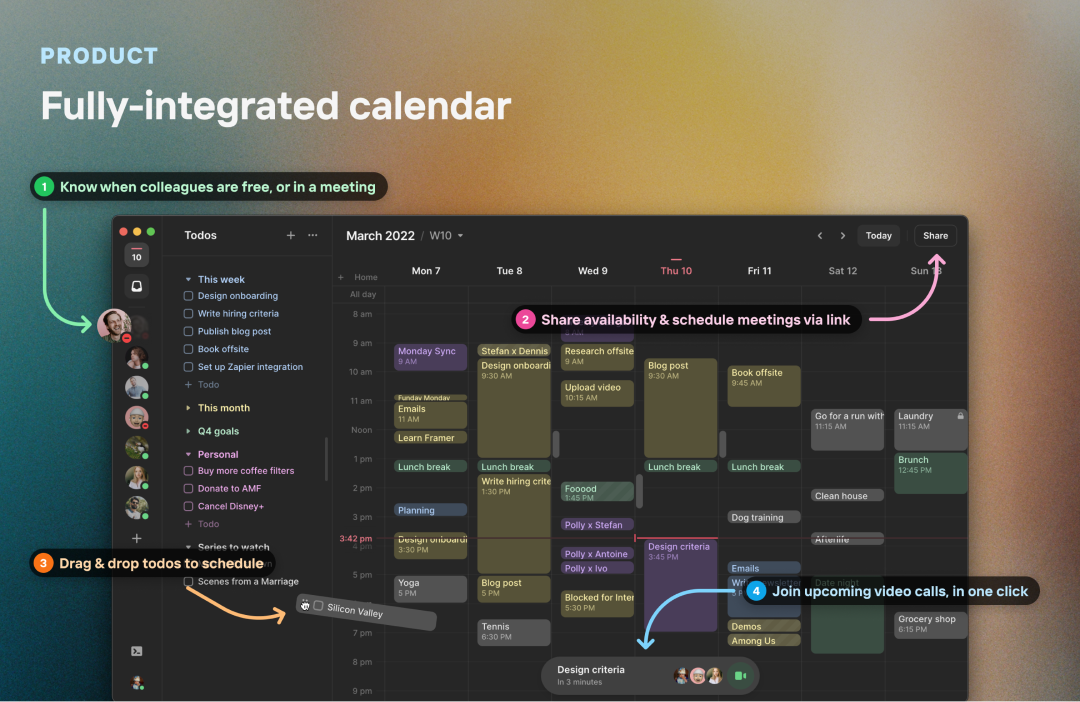Back to all comparisons
Asana vs Amie
Comprehensive comparison to help you choose the right tool for your needs

Asana
4.6
Asana is a project management tool focused on team collaboration and work organization, offering multiple views for task management, app integrations, and AI features for efficiency. It's suitable for various team sizes, streamlining workflows and aligning goals.
Asana offers three plans: the free Personal plan for basic needs, the Starter plan at $11.59 for expanded features like timeline view, and the Advanced plan at $25.69 for comprehensive project management tools including time tracking and advanced customization.
Visit Website 
Amie
4.6
Amie is a calendar and task management application designed to be the central hub for managing time. It combines a well-designed calendar with todo list management, featuring integrations with popular productivity apps for a unified task view. Focused on time-blocking and scheduling, Amie aims to streamline and enhance personal and professional time management.
$12.50/month (billed annually) or $15/month with no annual commitment, five-year plan at $500 for long-term savings
Visit Website Quick Summary
Asana Strengths
- Task Management: Asana excels in task management, allowing users to create, assign, and track tasks efficiently. This feature ensures that team members are always aware of their responsibilities and deadlines, promoting productivity and accountability.
- Project Visualization: With options like Kanban boards and Gantt charts, Asana offers versatile visualization tools. These features aid in understanding the project flow and milestones, making it easier to manage timelines and resources.
- Team Collaboration: Asana fosters seamless team collaboration. It allows for easy communication within tasks, sharing of files, and updating progress, thus keeping everyone on the same page and enhancing teamwork.
- Integration Capabilities: The platform integrates with a wide range of other applications and tools, streamlining workflows and automating processes. This integration makes it a flexible tool that can adapt to various business ecosystems.
Amie Strengths
- Calendar and Task Integration: Amie combines a traditional calendar with task management, allowing users to view their schedule and tasks in one unified interface.
- Integration with Popular Productivity Apps: The app integrates with tools like Todoist, Notion, and Linear, enabling users to centralize their workflow.
- Subtasks and Detailed Task Management: Users can break down tasks into subtasks, offering detailed organization and tracking capabilities.
- Meeting Booking Feature: Amie simplifies the process of scheduling meetings, integrating this function directly into the calendar interface.
Asana Screenshot

Amie Screenshot

Feature Comparison
| Feature | Asana | Amie |
|---|---|---|
| Platforms | macOS, iOS, Android, Web, and Windows | macOS, iOS, and Web |
| Integrations | Google Drive, Slack, Zoho Cliq, Zapier, Jira, Zoom, Toggl Track, Loom, Harvest, Gmail | Apple Health, Spotify, Linear, Things, Todoist, Notion, Zoom, Things 3, and TickTick |
| Calendar | Yes | Yes |
| Task Management | Task creation and assignment, due date setting, progress tracking, project organization, tagging, comments, file attachments, task conversations | Organizing tasks, subtasks, setting reminders, and scheduling tasks using natural language |
| Natural Language Processing | Yes | Yes |
| Analytics | Yes | No |
| Time Blocking | No | Yes |
| Time Zones | Yes | Yes |
| Scheduler | No | Yes |
| Notifications | Yes | Yes |
| Pricing | Asana offers three plans: the free Personal plan for basic needs, the Starter plan at $11.59 for expanded features like timeline view, and the Advanced plan at $25.69 for comprehensive project management tools including time tracking and advanced customization. | $12.50/month (billed annually) or $15/month with no annual commitment, five-year plan at $500 for long-term savings |
| Customer Support | Average | Good |
Video Overview
Asana Video
Amie Video
Asana Overview
Asana stands out as a versatile project management tool, ideal for various team sizes. Its user-friendly interface, coupled with diverse features like task management, project visualization (including Kanban and Gantt charts), and robust team collaboration tools, makes it a top choice. Additionally, Asana's integration capabilities with other apps enhance workflow efficiency. Offering a range of pricing plans, including a free version for smaller teams, Asana caters to a broad spectrum of organizational needs. It's particularly recommended for its ease of use, extensive integrations, and comprehensive project management features.
Pricing Details
Asana offers three main pricing tiers: (i) Personal: This is a free plan, suitable for small teams or individuals. It includes basic project and task management features and supports collaboration with up to 10 team members. Users have access to unlimited tasks, projects, messages, and file storage. (ii) Starter: Priced at $11.59 per user per month, this plan builds on the Personal plan. It allows collaboration with up to 500 teammates and introduces additional features like timeline and Gantt chart views, along with the ability to use forms and automation. (iii) Advanced: At $25.69 per user per month, the Advanced plan includes all features from the lower tiers and adds functionalities such as goals, time tracking, proofing, approvals, and more advanced customization options. Each tier offers a range of features to accommodate different needs, from individual use to more complex team collaboration and project management requirements.
Amie Overview
Amie is a modern calendar app designed to blend calendar functionality with task management. It integrates task lists and subtasks into a well-designed calendar application, offering a variety of integrations with popular productivity apps like Todoist, Notion, and Linear. Amie aims to centralize all tasks into one view for easy scheduling and time management. Additionally, it includes features for booking meetings and integrations with Spotify and Apple Health. While focused on Google Calendar integration, it plans to expand to others like Apple Calendar. The app is known for its fluid and fast performance on both mobile and desktop platforms.
Pricing Details
Amie Calendar offers several pricing options for its Amie Pro subscription: (i) Monthly Billing (Annual Commitment): The cost is $12.50 per month, billed annually. This means you will be billed a total of $150 for the year. (ii) Monthly Billing (No Annual Commitment): If you prefer not to commit annually, the cost is $15 per month, billed monthly. (iii) Five-Year Plan: For a long-term commitment, there is a five-year plan available at $500, which offers a significant saving over the monthly options.
Asana Key Features
Task Management: Asana excels in task management, allowing users to create, assign, and track tasks efficiently. This feature ensures that team members are always aware of their responsibilities and deadlines, promoting productivity and accountability.
Project Visualization: With options like Kanban boards and Gantt charts, Asana offers versatile visualization tools. These features aid in understanding the project flow and milestones, making it easier to manage timelines and resources.
Team Collaboration: Asana fosters seamless team collaboration. It allows for easy communication within tasks, sharing of files, and updating progress, thus keeping everyone on the same page and enhancing teamwork.
Integration Capabilities: The platform integrates with a wide range of other applications and tools, streamlining workflows and automating processes. This integration makes it a flexible tool that can adapt to various business ecosystems.
Customization and Reporting: Asana offers extensive customization options, including custom fields and reporting features. These allow teams to tailor their project management experience and generate insightful reports for better decision-making.
User-Friendly Interface: The intuitive interface of Asana is designed for ease of use, making it accessible for teams regardless of their technical expertise. This simplicity ensures a smooth onboarding process and enhances overall user experience.
Amie Key Features
Calendar and Task Integration: Amie combines a traditional calendar with task management, allowing users to view their schedule and tasks in one unified interface.
Integration with Popular Productivity Apps: The app integrates with tools like Todoist, Notion, and Linear, enabling users to centralize their workflow.
Subtasks and Detailed Task Management: Users can break down tasks into subtasks, offering detailed organization and tracking capabilities.
Meeting Booking Feature: Amie simplifies the process of scheduling meetings, integrating this function directly into the calendar interface.
Integrations with Spotify and Apple Health: These unique integrations bring an additional layer of personalization, allowing users to connect their daily routines with music and health data.
Performance Across Platforms: Known for its fluid and fast performance, Amie works seamlessly on both mobile and desktop platforms, ensuring a consistent user experience.
Conclusion: Which Tool Should You Choose?
Both Asana and Amie offer unique features and benefits for productivity and workflow management. The best choice depends on your specific needs, team size, and workflow preferences.
Choose Asana if:
- Task Management: Asana excels in task management, allowing users to create, assign, and track tasks efficiently. This feature ensures that team members are always aware of their responsibilities and deadlines, promoting productivity and accountability.
- Project Visualization: With options like Kanban boards and Gantt charts, Asana offers versatile visualization tools. These features aid in understanding the project flow and milestones, making it easier to manage timelines and resources.
- Team Collaboration: Asana fosters seamless team collaboration. It allows for easy communication within tasks, sharing of files, and updating progress, thus keeping everyone on the same page and enhancing teamwork.
Choose Amie if:
- Calendar and Task Integration: Amie combines a traditional calendar with task management, allowing users to view their schedule and tasks in one unified interface.
- Integration with Popular Productivity Apps: The app integrates with tools like Todoist, Notion, and Linear, enabling users to centralize their workflow.
- Subtasks and Detailed Task Management: Users can break down tasks into subtasks, offering detailed organization and tracking capabilities.